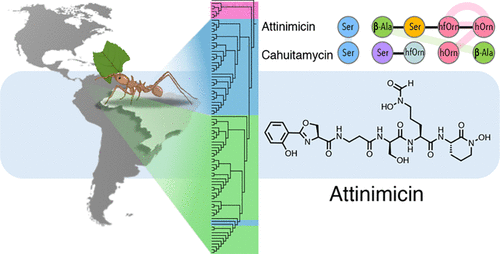当前位置:
X-MOL 学术
›
ACS Cent. Sci.
›
论文详情
Our official English website, www.x-mol.net, welcomes your
feedback! (Note: you will need to create a separate account there.)
Specialized Metabolites Reveal Evolutionary History and Geographic Dispersion of a Multilateral Symbiosis
ACS Central Science ( IF 12.7 ) Pub Date : 2021-01-20 , DOI: 10.1021/acscentsci.0c00978 Taise T. H. Fukuda 1, 2 , Eric J. N. Helfrich 1, 3, 4 , Emily Mevers 1, 5 , Weilan G. P. Melo 2 , Ethan B. Van Arnam 1, 6 , David R. Andes 7 , Cameron R. Currie 8 , Monica T. Pupo 2 , Jon Clardy 1
ACS Central Science ( IF 12.7 ) Pub Date : 2021-01-20 , DOI: 10.1021/acscentsci.0c00978 Taise T. H. Fukuda 1, 2 , Eric J. N. Helfrich 1, 3, 4 , Emily Mevers 1, 5 , Weilan G. P. Melo 2 , Ethan B. Van Arnam 1, 6 , David R. Andes 7 , Cameron R. Currie 8 , Monica T. Pupo 2 , Jon Clardy 1
Affiliation

|
Fungus-growing ants engage in a multilateral symbiosis: they cultivate a fungal garden as their primary food source and host symbiotic actinobacteria (Pseudonocardia spp.) that provide chemical defenses. The bacterial symbionts produce small specialized metabolites that protect the fungal garden from specific fungal pathogens (Escovopsis spp.), and in return, they are fed by the ant hosts. Multiple studies on the molecules underlying this symbiotic system have led to the discovery of a large number of structurally diverse antifungal molecules, but somewhat surprisingly no shared structural theme emerged from these studies. A large systematic study of Brazilian nests led to the discovery of the widespread production of a potent but overlooked antifungal agent, which we named attinimicin, by nearly two-thirds of all Pseudonocardia strains from multiple sites in Brazil. Here we report the structure of attinimicin, its putative biosynthetic gene cluster, and the evolutionary relationship between attinimicin and two related peptides, oxachelin A and cahuitamycin A. All three nonribosomal peptides are structural isomers with different primary peptide sequences. Attinimicin shows iron-dependent antifungal activity against specific environmental fungal parasites but no activity against the fungal cultivar. Attinimicin showed potent in vivo activity in a mouse Candida albicans infection model comparable to clinically used azole-containing antifungals. In situ detection of attinimicin in both ant nests and on worker ants supports an ecological role for attinimicin in protecting the fungal cultivar from pathogens. The geographic spread of the attinimicin biosynthetic gene cluster in Brazilian Pseudonocardia spp. marks attinimicin as the first specialized metabolite from ant-associated bacteria with broad geographic distribution.
中文翻译:

专业代谢物揭示了多边共生的进化历史和地理分布。
真菌生长的蚂蚁参与多边共生:它们以真菌园为主要食物来源,并拥有提供化学防御作用的共生放线菌(Pseudonocardia spp。)。细菌共生体产生小的专门代谢产物,可以保护真菌花园免受特定的真菌病原体的侵害(Escovopsisspp。),作为回报,它们由蚂蚁宿主喂食。对该共生系统基础分子的多项研究导致发现了许多结构多样的抗真菌分子,但令人惊讶的是,这些研究没有发现共有的结构主题。导致广泛生产的发现巴西巢的大系统研究一种有效的,但忽视了抗真菌剂,这是我们命名attinimicin,所有的近三分之二假来自巴西多个地点的菌株。在这里我们报告了attinimicin的结构,其假定的生物合成基因簇以及attinimicin与两种相关肽oxachelin A和cahuitamycin A之间的进化关系。所有三种非核糖体肽都是具有不同主要肽序列的结构异构体。Attinimicin对特定的环境真菌寄生虫显示铁依赖性的抗真菌活性,但对真菌品种没有活性。在小鼠白色念珠菌感染模型中,Attinimicin显示出有效的体内活性,可与临床使用的含唑类抗真菌剂相提并论。原位在蚂蚁巢中和工蚁上检测到Attinimicin有助于Attinimicin在保护真菌品种免受病原体侵害方面发挥生态作用。在巴西的attinimicin生物合成基因簇的地理分布假属。标志着attinimicin是来自蚂蚁相关细菌的首个专门代谢产物,具有广泛的地理分布。
更新日期:2021-02-24
中文翻译:

专业代谢物揭示了多边共生的进化历史和地理分布。
真菌生长的蚂蚁参与多边共生:它们以真菌园为主要食物来源,并拥有提供化学防御作用的共生放线菌(Pseudonocardia spp。)。细菌共生体产生小的专门代谢产物,可以保护真菌花园免受特定的真菌病原体的侵害(Escovopsisspp。),作为回报,它们由蚂蚁宿主喂食。对该共生系统基础分子的多项研究导致发现了许多结构多样的抗真菌分子,但令人惊讶的是,这些研究没有发现共有的结构主题。导致广泛生产的发现巴西巢的大系统研究一种有效的,但忽视了抗真菌剂,这是我们命名attinimicin,所有的近三分之二假来自巴西多个地点的菌株。在这里我们报告了attinimicin的结构,其假定的生物合成基因簇以及attinimicin与两种相关肽oxachelin A和cahuitamycin A之间的进化关系。所有三种非核糖体肽都是具有不同主要肽序列的结构异构体。Attinimicin对特定的环境真菌寄生虫显示铁依赖性的抗真菌活性,但对真菌品种没有活性。在小鼠白色念珠菌感染模型中,Attinimicin显示出有效的体内活性,可与临床使用的含唑类抗真菌剂相提并论。原位在蚂蚁巢中和工蚁上检测到Attinimicin有助于Attinimicin在保护真菌品种免受病原体侵害方面发挥生态作用。在巴西的attinimicin生物合成基因簇的地理分布假属。标志着attinimicin是来自蚂蚁相关细菌的首个专门代谢产物,具有广泛的地理分布。











































 京公网安备 11010802027423号
京公网安备 11010802027423号